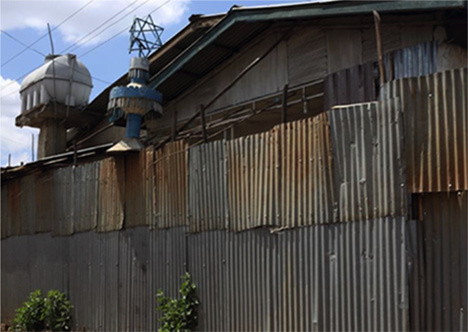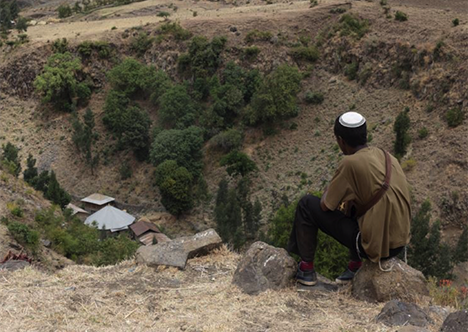 Exterior View (2005), 15” x 11” Photograph, Jay A. Waronker
Exterior View (2005), 15” x 11” Photograph, Jay A. Waronker
ethiopia
Bet Selam (House of Peace) Synagogue |
|

Exterior View (2005), 11” x 15” Photograph, Jay A. Waronker
|
According to their oral history, the Beta Abraham Jews of Semien (North) Shewa, Ethiopia settled in Kechene when Menelik II (1844 – 1913) built a palace in Entoto, north of today's Addis Ababa. Semien Shewa in central Ethiopia is one of ten zones of the Amhara Region of Ethiopia, and it takes its name from the kingdom or former province of Shewa. As per this narrative, the king needed laborers for their skills in construction, craft making, and weapons production.
The Kechene Jews, who share ancestral origins with the Beta Israel community of Ethiopia, have an uncertain origin. Their name is derived from an area of Addis Ababa. Their unconfirmed ancestry range from being descendants of theancient tribe of Dan. A second group claims descent from the Israelites who accompanied Menelik I, the son of King Solomon and the Queen of Sheba, on his journey from Israel to Ethiopia. Others, particularly from the Q’uara region, believe they are descended from the Levites who brought the Ark of the Covenant to Ethiopia for safe keeping when Jerusalem was ruled by a pagan King around 500 BC. And still others claim ancestry from those Israelites who fled Jerusalem when Babylon destroyed the city. The total population of Kechene Jews is estimated currently to be more than 100,000. They are skilled craftsmen, involved in the production of ploughshares, metal agricultural implements, knives, blades, iron spears, swords, pottery, and traditional clothing.
Separation of the Kechene Jews form the Beta Israel, however, began at the time Kassa of Q’uara crowned himself Emperor Tewodros II of Ethiopia in 1855. As was the custom at that time, the new Emperor captured and detained all potential rivals to prevent internal power struggle. One of his prisoners was the young Shewan prince Menelik.
For years the Jews of Kechene continued practicing Judaism in secret as per the direction of the leaders who remained in North Shewa. In more recent years, however, a group of young people from Kechene decided to disclose their Jewish faith. In time they opened a synagogue in the heart of Kechene, which led to friction between the youth and elders.
Other synagogues to serve the regional Beta Israel have for some time existed outside of Kechene, yet their locations are kept secret and visitors are generally not welcome. These small buildings are located in remote areas of the mountains, and getting to them is a long and arduous undertaking. This strategy of building synagogues in isolated inaccessible places has protected the community for centuries.
The compound does not contain Jewish symbols. This is for two reasons. The first is to stave off unwelcome attention from hostile neighbors. The second is that most modern Jewish symbols, such as the Star of David, are simply unknown to the members of the community. There are two entrances to the synagogue, one for men and another for women. Most of the prayers are conducted in Ge’ez, the liturgical language of Beta Israel. Surprisingly, the spoken language of many community elders is Quarenya, a language of an area near Dembiya.
Another interesting feature of the synagogues is that they are always located near a river because the Jews of North Shewa strictly observe the Biblical laws of ritual purity, or niddah.
